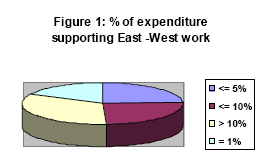NSEC Consultation Data Generated
The research team worked with NSEC at the beginning of their consultation design. They are only in July 2006 starting to ramp up their consultation activities. Consequently the research team cannot present a lot of data from the time before the research project ended.
Reason for the trial
For the research, this trial has been about learning how to design e-consultations, not the participant responses. The early consultation data generated was mostly from the hand-held voting during the launch meeting. In 10 minutes the audience answered six questions.
Survey outcomes
Key outcomes of the survey indicated that there was widespread awareness amongst the respondents of North-South Educational exchanges: over 80% were aware of 5 or more programmes.
More specifically the results of the survey showed:
- 71% wished to see a widening of the funding area to include non-border areas. This would widen the scope and range of the programmes to have a stronger all-Ireland focus.
- On the issues of east-west work, the respondents were more equally divided as shown in the .
- The ages of the participants was an important issue, as it referenced the age cohorts that the respondents felt the programme participants should come from. Respondents felt that by default this had a very significant bearing on the type of programme delivered and the expected outcomes. Over 80% of the respondents felt that the age groups involved should be between 10 and 19 years.
- The matter of social exclusion was dealt with at various levels, and the majority of respondents (40%), felt that the funding mechanisms should be restructured to allow for up to 50% of monies to be targeting at socially excluded groups. This high response rate does not however take account of the fact that most programmes have some element of targeting socially excluded groups built into them.
Overall, generated data was low... but web site usage higher
The actual data generated by the e-consultation on-line survey launched at the same time was low; however, further analysis of web traffic indicated that there was increased activity on the web page - people were using the site to download reports and files, but not completing the survey.
